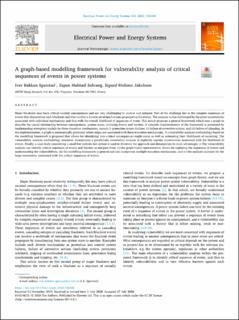| dc.contributor.author | Sperstad, Iver Bakken | |
| dc.contributor.author | Solvang, Espen Hafstad | |
| dc.contributor.author | Jakobsen, Sigurd Hofsmo | |
| dc.date.accessioned | 2020-08-25T09:21:17Z | |
| dc.date.available | 2020-08-25T09:21:17Z | |
| dc.date.created | 2020-08-18T22:04:01Z | |
| dc.date.issued | 2020 | |
| dc.identifier.issn | 0142-0615 | |
| dc.identifier.uri | https://hdl.handle.net/11250/2673847 | |
| dc.description.abstract | Major blackouts may have critical societal consequences and are very challenging to analyse and mitigate. Part of the challenge lies in the complex sequences of events that characterize such blackouts and that involve a diverse set of mechanisms propagating the events. The analysis is also challenged by the great uncertainties associated with individual mechanisms and thus with the overall likelihood of sequences of event. This article proposes a general framework which uses a graph to describe the causal relationship between consequences, system states, initiating events and barriers. A concrete implementation of the framework is presented by implementing exemplary models for three transition mechanisms, namely i) protection system failures, ii) failure of corrective actions, and iii) failure of islanding. In the implementation, a graph is automatically generated where edges are associated with these transition mechanisms. A vulnerability analysis methodology based on the modelling framework is proposed that allows for identifying how critical consequences might occur as well as estimating their likelihoods of occurring. The vulnerability analysis methodology moreover incorporates a possibilistic uncertainty analysis to explicitly capture uncertainties associated with the likelihood of events. Finally, a case study considering a small but realistic test system is used to illustrate the approach and demonstrate its main advantages: i) The vulnerability analysis can identify critical sequences of events and barriers to mitigate them, ii) the graph-based representation allows for exploring the sequences of events and understanding the vulnerabilities, iii) the modelling framework is general and can incorporate multiple transition mechanisms, and iv) the analysis accounts for the large uncertainty associated with the critical sequences of events. | en_US |
| dc.description.sponsorship | Norges forskningsråd | en_US |
| dc.language.iso | eng | en_US |
| dc.publisher | Elsevier | en_US |
| dc.relation.uri | https://zenodo.org/record/3491916 | |
| dc.rights | Navngivelse 4.0 Internasjonal | * |
| dc.rights.uri | http://creativecommons.org/licenses/by/4.0/deed.no | * |
| dc.title | A graph-based modelling framework for vulnerability analysis of critical sequences of events in power systems | en_US |
| dc.type | Journal article | en_US |
| dc.type | Peer reviewed | en_US |
| dc.description.version | publishedVersion | en_US |
| dc.rights.holder | The Authors | en_US |
| dc.source.pagenumber | 106408 | en_US |
| dc.source.volume | 125 | en_US |
| dc.source.journal | International Journal of Electrical Power & Energy Systems | en_US |
| dc.identifier.doi | 10.1016/j.ijepes.2020.106408 | |
| dc.identifier.cristin | 1823926 | |
| dc.relation.project | Norges forskningsråd: 255226 | en_US |
| cristin.ispublished | true | |
| cristin.fulltext | original | |
| cristin.qualitycode | 1 | |

